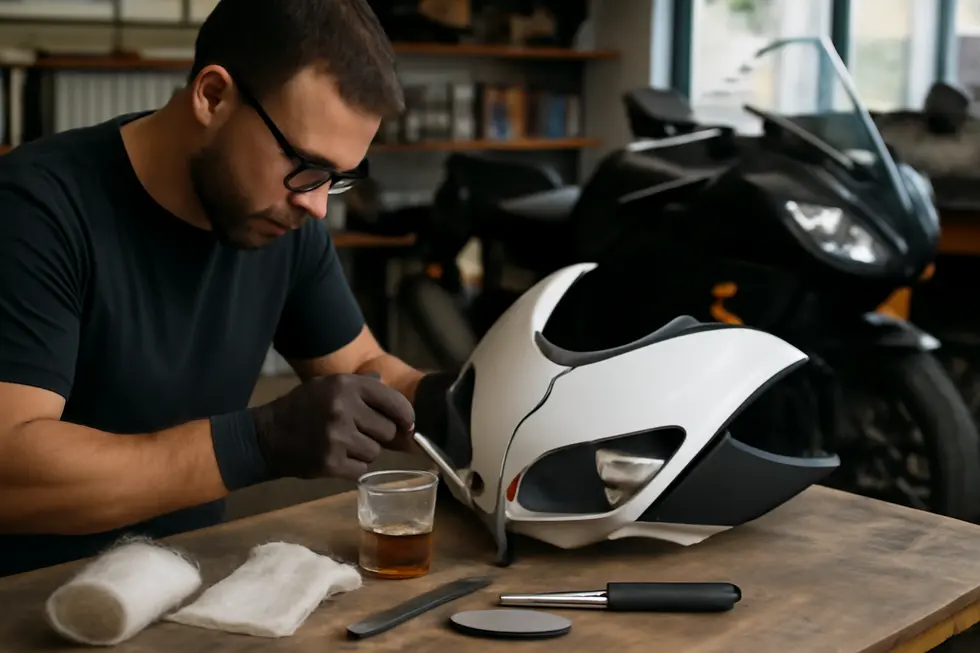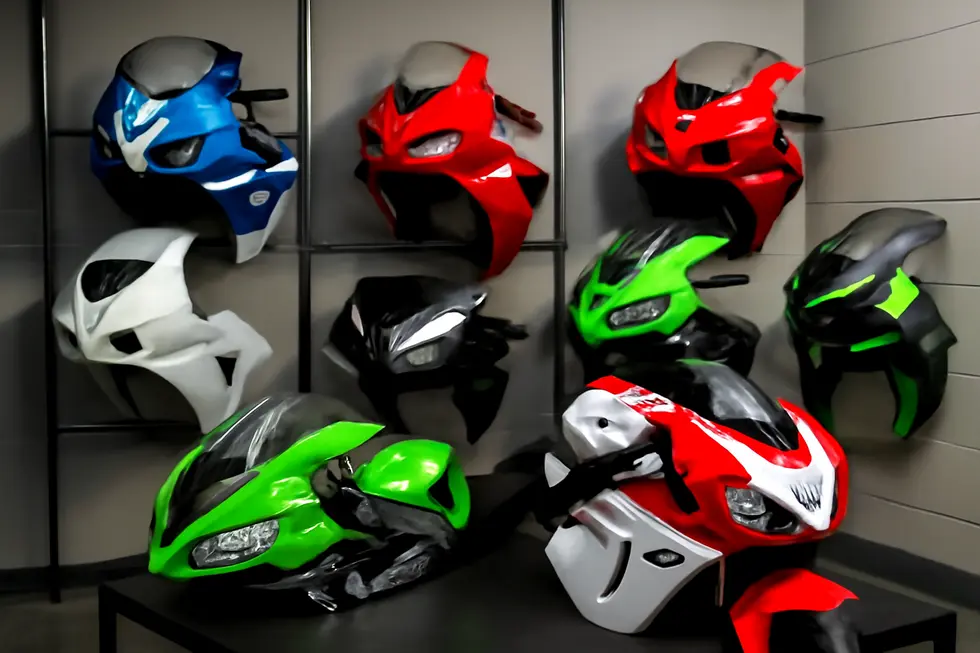Mastering Motorcycle Fairing Scratch Repair: Techniques, Materials, and Market Opportunities
October 15, 2025 | by summitfairings
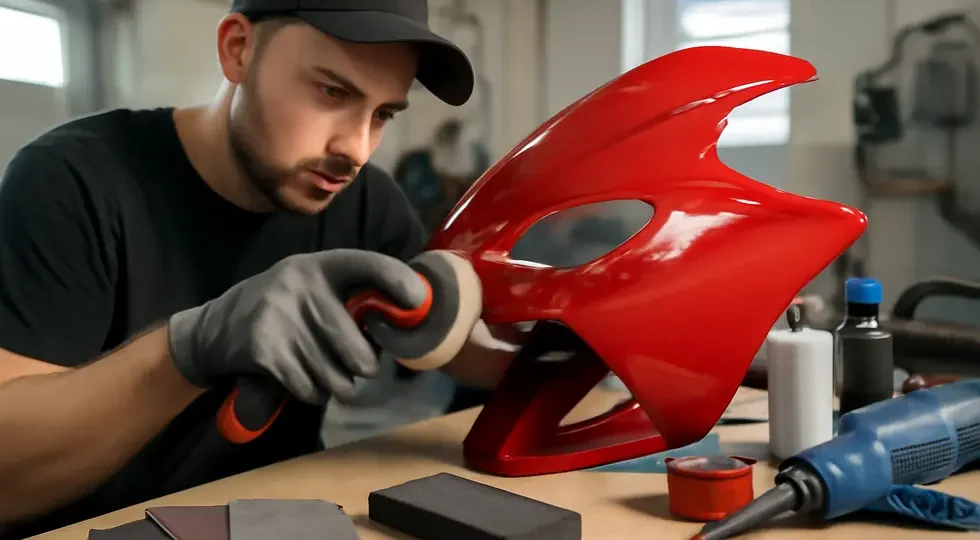
Introduction
Motorcycle fairings serve not only as protective and aerodynamic bodywork but also as critical aesthetic components influencing a bike’s market value and appeal. For business owners operating repair shops, dealerships, or customization boutiques, mastering the art and science of fairing scratch repair unlocks avenues for cost savings, customer loyalty, and brand differentiation. Understanding the meticulous preparation, polishing, and refinishing processes enables effective restoration that preserves originality and enhances appearance. Equally important is knowing the right materials and methods to use, along with economic considerations that impact profitability and operational efficiency. Keeping pace with ongoing advancements and troubleshooting common challenges further ensures consistent, high-quality outcomes. This article explores these facets sequentially—from preparatory techniques and polishing to materials, economic factors, and finally recent innovations and practical tips—empowering business owners to excel in motorcycle fairing scratch repair and maximize their service offerings.
Tables of Contents
Chapter 1: Mastering Preparation and Polishing for Flawless Motorcycle Fairing Scratch Repair
- Essential Cleaning and Surface Conditioning for Optimal Fairing Scratch Refinement
- Mastering Wet Sanding and Polishing: Essential Steps for Flawless Motorcycle Fairings
- Mastering Touch-Up Paint and Clear Coat Application for Flawless Fairing Repairs
- Mastering Polishing Methods and Compound Selection for Flawless Motorcycle Fairings
- Enhancing Durability and Shine: The Role of Protective Wax and Ceramic Coatings in Motorcycle Fairing Refinement
Chapter 2: Materials, Methods, and Economic Factors in Motorcycle Fairing Scratch Repair
- Essential Materials for Motorcycle Fairing Scratch Repair: Choosing the Right Plastics and Composites for Lasting Results
- Advanced Repair Techniques and Material Innovations Shaping Motorcycle Fairing Scratch Restoration
- Balancing Costs and Quality: Economic Insights into Materials and Methods for Motorcycle Fairing Scratch Repair
- Sustainable Materials and Repair Practices: Environmental and Consumer Impacts on Fairing Scratch Restoration
- Navigating Global Supply Chains and Economic Forces in Sourcing Fairing Repair Materials
Chapter 3: Advancements, Challenges, and Practical Tips in Motorcycle Fairing Scratch Repair
- Cutting-Edge Materials and Precision Techniques Transforming Motorcycle Fairing Scratch Repairs
- Navigating Material Sensitivities and Environmental Obstacles in Motorcycle Fairing Scratch Repairs
- Essential Step-by-Step Techniques for Effective Motorcycle Fairing Scratch Restoration
- Navigating Cost, Quality, and Availability in Motorcycle Fairing Scratch Restoration
- Fostering Rider Empowerment through Education: Enhancing Motorcycle Fairing Scratch Repair Skills and Community Impact
Chapter 1: Mastering Preparation and Polishing for Flawless Motorcycle Fairing Scratch Repair
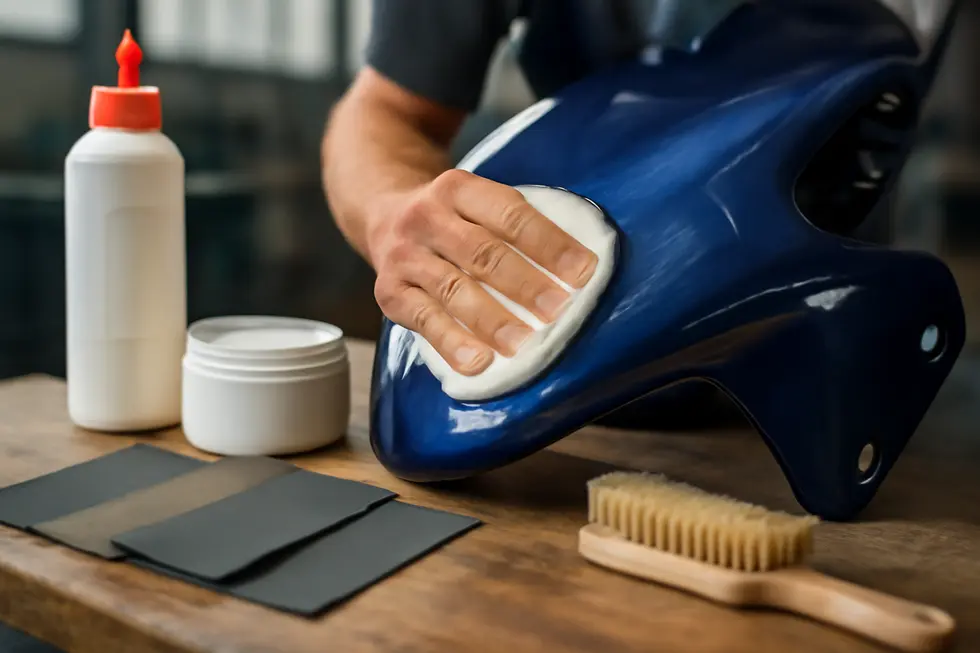
1. Essential Cleaning and Surface Conditioning for Optimal Fairing Scratch Refinement
The foundation of any successful motorcycle fairing scratch repair lies in meticulous cleaning and surface preparation, which directly influence the final appearance and durability of the repair. Initially, the fairing must be cleansed of all contaminants—such as dirt, grease, wax, silicone, and oils—that can obstruct adhesion during sanding, priming, or painting. Employing a dedicated wax and grease remover or brake cleaner ensures these residues are effectively eliminated without harming the plastic substrate. Following this, washing the surface with mild soap and water softens grime safely, while drying with non-abrasive cloths prevents new micro-scratches.
Once the fairing is spotless, preparing the surface begins with sanding. This step targets the roughness caused by scratches and introduces a uniform texture for subsequent treatments. A progression from coarse to ultra-fine grit sandpapers (starting around 320 grit and advancing up to 2000 or even 3000 grit) is essential. Wet sanding is practiced throughout to minimize dust and reduce friction-generated heat that might deform the plastic. This gradual refinement removes imperfections and dulls shiny patches, creating a consistent matte canvas that enhances primer, paint, and polish adhesion.
For scratches that cut deeper into paint layers, touch-up paint can be applied after sanding, followed by light sanding to blend repairs invisibly. It is critical to remove all sanding residues since leftover dust will compromise the polish or paint finish. Polishing then brings the surface back to life by gently rubbing fine polishing compounds with soft pads in overlapping circular motions. This controlled approach avoids overheating and plastic distortion, restoring clarity and smoothness.
Completing the preparation, a protective sealant like wax or ceramic coating is applied. These layers not only preserve the shine and protect against UV damage but also guard against environmental wear, ensuring longevity of the repair. For further insights on polishing sequences and surface care, refer to this comprehensive resource on motorcycle fairings.
This combined process—thorough cleaning, careful sanding progression, residue removal, and mindful polishing—forms the backbone of flawless motorcycle fairing scratch repair and the pathway to restoring your fairing’s original brilliance.
2. Mastering Wet Sanding and Polishing: Essential Steps for Flawless Motorcycle Fairings
Wet sanding stands as a foundational technique in preparing motorcycle fairings to regain a smooth and polished surface after scratches. This process involves carefully abrading the affected areas using water-lubricated sandpaper with progressively finer grits, typically moving from around 400-600 grit up to an ultra-fine 1200-2000 grit range. The water acts as a lubricant to minimize heat and clogging, which protects the plastic or composite surfaces and preserves the underlying clear coat as much as possible.
A delicate touch is essential during wet sanding; excessive or aggressive sanding risks removing too much paint or clear coat, requiring additional refinishing steps. When carrying out this step, it is best to maintain consistent, light pressure and keep the surface continuously wet. This cautious approach prevents surface gouging and ensures the scratch edges are feathered into the undamaged area for a seamless repair.
Following the smoothing of scratches through wet sanding, polishing compounds are applied to restore the fairing’s gloss and refine the finish further. Using soft foam pads in gentle, circular motions, these compounds eliminate fine sanding marks, swirl patterns, and minor blemishes. The polishing step effectively bridges the gap between a freshly sanded surface and a showroom-quality shine, enhancing both appearance and protective qualities.
Implementing these wet sanding and polishing techniques allows for meticulous repair of scratches while maintaining the integrity of the fairing’s surface. For those aiming to deepen their understanding of surface preparation and prolong the life of motorcycle fairings, this stage is indispensable. It naturally follows the initial cleaning phase and leads directly into repainting or applying protective layers for an outstanding final result.
To explore more about keeping your fairings in top condition and practical repair advice, consider this resource offering detailed insights into motorcycle fairing maintenance and restoration techniques.
3. Mastering Touch-Up Paint and Clear Coat Application for Flawless Fairing Repairs
Achieving a seamless restoration of motorcycle fairing scratches hinges on the precise application of touch-up paint followed by a protective clear coat. This process begins with meticulous cleaning to remove wax, grease, and contaminants that could undermine paint adhesion. Ensuring the surface is pristine allows each subsequent layer to bond securely, avoiding imperfections in the final finish. Once cleaned, the fairing section is sanded progressively, starting with coarser grits to eliminate rough edges and scratches, gradually refining with fine 1500 to 2000 grit sandpaper to create a flawlessly smooth canvas.
Touch-up paint is then applied with deliberate care to fill deeper scratches or chips, restoring the fairing’s base color and texture beneath the clear coat. This crucial step rebuilds the substrate, ensuring the repair won’t be visible once polished. After allowing the paint to dry fully, the clear coat is painted over the touch-up area. This transparent layer seals the paint, guards against environmental damage like UV fading or abrasion, and imparts a consistent gloss that merges with the original finish.
To perfect the surface, the clear coat undergoes wet sanding using ultra-fine grit paper, which smooths out any minor unevenness without cutting through to the color layer. Following this, polishing with specialized compounds and soft pads restores shine and blends the repair with the surrounding fairing. The polished clear coat produces a uniform, durable finish that enhances both appearance and longevity.
Each phase, from initial cleaning through final polish, is essential for a high-quality repair, balancing careful technique with material compatibility. For detailed demonstrations of these steps, explore the best motorcycle fairings at Summit Fairings, where expert video guides effectively highlight sanding, painting, clear coating, and polishing processes in action.
4. Mastering Polishing Methods and Compound Selection for Flawless Motorcycle Fairings
Polishing motorcycle fairings to restore their sleek finish demands a precise approach that balances surface protection with effective scratch removal. The process begins with thorough cleaning to eliminate dirt, oils, and wax residues using gentle cleaners designed for plastics. This crucial step prevents embedding contaminants during sanding or polishing, which could jeopardize the final finish and adhesion of subsequent layers.
Next, careful sanding is applied to level scratches and imperfections. Light sanding with fine-grit sandpaper, typically between 320 to 400 grit, smooths glossy spots and preps the surface without causing damage. Maintaining a wet surface during sanding reduces the risk of scratching deeper or overheating the fairing material.
Following sanding, the use of cutting compounds formulated for plastic or clear coat surfaces becomes essential. These compounds contain fine abrasives that gradually remove light scratches and swirl marks while preserving the plastic’s integrity. Starting with a mild cutting compound helps avoid hazing or over-polishing, important to keep the fairing’s original texture intact. For deeper and more stubborn scratches, controlled heat treatment or plastic fillers may be necessary to achieve a uniform surface before polishing.
Polishing compounds and the choice of pads play a pivotal role in enhancing gloss and achieving a flawless finish. Soft polishing pads used with polishing compounds refine the surface gently, employing small circular motions for even coverage and minimizing heat buildup which could deform plastic components. Transitioning from harder cutting pads to softer finishing pads allows for better control and increases the clarity of the shine.
Testing the compounds on an inconspicuous area before full application helps ensure compatibility with the fairing’s paint and material. Performing polishing in a clean, temperature-controlled, and dust-free environment further improves results, preventing surface contamination.
After polishing, applying protective coatings such as ceramic or spray coatings seals the work, boosting both shine and surface durability. Proper preparation steps, including surface decontamination with clay bars and removal of swirl marks, are required for these coatings to bond effectively.
For structural issues like cracks, plastic welding offers a superior repair method to adhesives, strengthening the fairing before any polishing work begins. This integrated approach to cleaning, sanding, cutting, polishing, and protective finishing restores motorcycle fairings to their near-original condition with lasting resilience.
For detailed, step-by-step polishing demonstrations tailored to motorcycle fairings, the Summit Fairings guide provides valuable insights and techniques on effective buffing and compound use, enhancing the quality and durability of your repair efforts.
5. Enhancing Durability and Shine: The Role of Protective Wax and Ceramic Coatings in Motorcycle Fairing Refinement
Achieving a lasting and glossy finish on repaired motorcycle fairings depends heavily on the final stages of protection after polishing. Following thorough cleaning and the careful removal of scratches, the application of protective wax or ceramic coatings plays a pivotal role in both enhancing appearance and shielding the surface from environmental damage. Protective wax acts as a sacrificial layer, filling microscopic pores in the paint or clear coat to boost gloss and provide a defensive barrier against UV rays, oxidation, and contaminants. Its relative ease of application makes it a practical choice for periodic maintenance, though its protective effects are temporary, typically lasting weeks to a few months.
For those seeking superior and long-lasting protection, ceramic coatings offer a significant upgrade. These advanced coatings chemically bond to the fairing’s surface, creating a robust, hydrophobic shield that repels water, dirt, and chemicals while resisting minor abrasions and UV degradation. The application process demands meticulous surface preparation—removal of oils, residues, and embedded particles using clay bars and specialized cleaners ensures the coating adheres flawlessly. Once applied in a thin, uniform layer and allowed to cure in a dust-free environment, ceramic coatings deliver protection that endures for years with proper care.
While both wax and ceramic coatings enhance gloss and preserve the repaired finish, ceramic coatings require more precise application techniques to avoid imperfections that can compromise durability. Integrating these coatings effectively after polishing not only restores the aesthetic appeal of fairings but also extends their lifespan, preventing premature fading and surface wear. This strategic combination completes the repair process, transforming scratched motorcycle fairings into resilient, showroom-quality surfaces. For additional insights on motorcycle fairing care, exploring expert resources on affordable motorcycle fairings can provide valuable guidance.
Chapter 2: Materials, Methods, and Economic Factors in Motorcycle Fairing Scratch Repair

1. Essential Materials for Motorcycle Fairing Scratch Repair: Choosing the Right Plastics and Composites for Lasting Results
Motorcycle fairing scratch repair demands a precise understanding of the materials involved, as the type of plastic or composite greatly influences both repair methods and material selection. The majority of OEM fairings are fashioned from thermoplastics such as ABS (Acrylonitrile Butadiene Styrene), polypropylene, and polycarbonate, each bringing distinct challenges and advantages. ABS, prized for its impact resistance and excellent weldability, lends itself well to repairs involving plastic welding and refinishing. Polypropylene, though lightweight and chemically resistant, poses adhesion challenges due to its low surface energy, often requiring specialized primers or adhesion promoters. Polycarbonate, featuring superior impact strength and visual clarity, can be less forgiving during repairs as it tends to crack rather than deform, calling for delicate sanding and polishing techniques. Beyond plastics, high-performance motorcycles frequently incorporate composites like fiberglass and carbon fiber. These materials, celebrated for strength-to-weight ratios and premium aesthetics, necessitate specialized repair protocols involving resin layup or careful gelcoat application to restore structural integrity and finish. Selecting repair materials hinges on matching chemical compatibility and mechanical properties to the base substrate—ensuring adhesion, durability, and maintaining flexibility where needed. Equally important is balancing repair complexity and cost, as materials like ABS often allow economical and straightforward restoration, while composite repairs involve higher expenses and expertise but yield superior longevity. A well-rounded repair approach integrates suitable sandpapers, plastic fillers, primers, and color-matched paints compatible with the original fairing materials, maintaining the motorcycle’s appearance and function. Considering future protection, incorporating clear coats and ceramic-based finishes can extend repair lifespan by shielding against UV and environmental degradation. For riders interested in exploring quality parts and repair options compatible with these materials, resources such as Explore the Best Motorcycle Fairings at Summit Fairings offer valuable insights.
2. Advanced Repair Techniques and Material Innovations Shaping Motorcycle Fairing Scratch Restoration
Motorcycle fairing scratch repairs demand an insightful blend of materials knowledge, skilled techniques, and an understanding of economic impact. Addressing everything from superficial blemishes to structural damage, repair methods vary widely in complexity and cost. For minor surface scratches, buffing and polishing remain the cornerstone technique. This process involves precise wet sanding with fine-grit sandpaper followed by the gentle application of plastic-specific polishing compounds. These compounds restore clarity and gloss without risking heat damage that might warp the plastic, while a final layer of protective wax or ceramic coating preserves the restored finish against UV rays and environmental wear. When cracks compromise fairing integrity, plastic welding offers a superior alternative to adhesive fixes. By fusing plastic components through heat, it creates a robust, lasting repair that often surpasses the strength of original joints, retaining the fairing’s structural reliability without costly replacement. For scratches that penetrate the paint layer, touch-up painting paired with clear coating is essential. This method integrates primer layers, precise color matching, and smooth blending through sanding and polishing to seamlessly restore aesthetics. Although more time-intensive and costly, it effectively revives color depth and gloss on damaged surfaces. In cases of extensive damage or modernization, replacement with parts fabricated from advanced composites, such as carbon fiber, may be economically justified. These materials offer enhanced performance with their superior strength-to-weight ratios, and recent manufacturing advancements have improved affordability and quality. Economic considerations influence method choice significantly—lower-cost techniques suit minor repairs, while labor-intensive plastic welding or repainting assure longevity, potentially offsetting higher initial expenses. Emerging technologies, including novel polishing agents and durable ceramic coatings, continue to refine repair effectiveness and cost-efficiency. For further practical insights and a wide selection of repair materials, exploring expert motorcycle fairing resources can offer valuable guidance on best practices and product options.
3. Balancing Costs and Quality: Economic Insights into Materials and Methods for Motorcycle Fairing Scratch Repair
Understanding the economic dynamics behind motorcycle fairing scratch repair is essential for both providers and motorcycle owners aiming to maximize value. Repairing damaged fairings usually offers a significant cost advantage over replacement. Materials and labor for repairs—typically ranging from minor polishing to full repainting—often cost a fraction of the price of new fairings, which can soar to several thousands of dollars depending on the bike’s make and model. This cost efficiency becomes especially relevant for high-end motorcycles where originality and preservation matter.
Pricing strategies adopted by repair services frequently reflect a balance between competitive market positioning and the complexity of repair methods. Tiered offerings allow customers to select from basic scratch repairs to advanced services involving repainting or plastic welding. Bundled services and loyal customer discounts can incentivize repeat business, reinforcing profitability while making quality repair accessible. However, challenges in pricing arise due to fluctuating costs of materials, including specialized paints and high-grade adhesives, as well as labor skill levels required for more delicate repairs.
Market trends also influence repair economics. The surge in do-it-yourself kits and online tutorials has heightened consumer awareness but has not entirely displaced demand for professional expertise, particularly in repairs requiring structural integrity or flawless finishes. Additionally, broader economic conditions drive consumer choice; recessions can increase preference for repairs over new parts, while inflation may pressure suppliers and service providers to adjust pricing accordingly.
Advancements in repair materials and methods, such as improved bonding agents and ceramic coatings, can reduce long-term costs by increasing durability. These innovations, however, may initially increase repair expenses. The key economic challenge is balancing upfront investment against lasting quality and customer satisfaction. For those interested in further exploring cost-effective options and material considerations, resources like detailed motorcycle fairing guides provide valuable insight.
4. Sustainable Materials and Repair Practices: Environmental and Consumer Impacts on Fairing Scratch Restoration
Motorcycle fairing scratch repair is increasingly influenced by environmental awareness and evolving consumer values that prioritize sustainability. The materials used, primarily ABS plastic and various composites like fiberglass and carbon fiber, carry differing environmental footprints. ABS, although widely recyclable, demands mindful repair approaches to limit waste and chemical use. Composites, while offering superior durability and performance, pose greater recycling challenges, yet advances in composite repurposing and recycling technologies are gradually mitigating long-term environmental impact.
Repair methods have similarly adapted toward greener practices. Traditional chemical abrasives and harsh polishing compounds generate waste and can degrade plastics if misused. Newer techniques favor plastic-safe polishing compounds and wet sanding that extend fairing lifespan without excessive surface damage. Plastic welding has emerged as a sustainable alternative to adhesives, restoring structural integrity without increasing hazardous waste. This method reduces the need for total fairing replacement, directly lowering material consumption and landfill contributions.
Economically, sustainable repair methods benefit consumers by decreasing replacement frequency and preserving the bike’s original aesthetic and value. Many riders now seek repair services that demonstrate environmental responsibility, matching rising public interest in eco-conscious choices seen across industries. This shift encourages repair shops to adopt eco-friendly compounds, durable UV-resistant coatings, and streamlined multi-step paint processes that reduce chemical use and waste.
Societal trends support a broader acceptance of sustainability-focused maintenance. Consumers increasingly favor businesses committed to reducing environmental impact, reinforcing a cycle where economic and ecological priorities align. As innovations in recyclable composites and plastic welding advance, motorcycle fairing repair reflects a growing integration of environmental stewardship, economic practicality, and consumer demand for sustainable motorcycling solutions.
For more insights on quality repairs that respect environmental concerns while maintaining affordability, exploring summit fairings’ expert resources offers valuable guidance and practical tips.
5. Navigating Global Supply Chains and Economic Forces in Sourcing Fairing Repair Materials
Motorcycle fairing scratch repair hinges not only on technique but also on the availability and cost of materials anchored in complex global supply chains. The predominant use of ABS plastic in fairings ties repair practices to petrochemical markets, whose raw materials primarily come from geopolitically sensitive regions. Volatility in oil prices and political tensions in petroleum-exporting countries directly impact ABS resin availability and pricing, reflecting in both repair material costs and lead times. Specialized repair components like UV-resistant paints, primers, and plastic welding additives further complicate sourcing since they often contain regulated chemicals produced by a limited number of manufacturers worldwide. Trade policies, tariffs, and export controls influence these supply routes, creating vulnerabilities to delays or price hikes. Manufacturing concentrations in countries with lower production costs provide affordable aftermarket fairings and kits but expose repair businesses and consumers to currency fluctuations and shipping disruptions. Consequently, repair shops must carefully balance economic dependencies against material quality to maintain reliability. Some technicians turn to locally available alternatives for scratch filling or patching, though these may sacrifice durability or finish integrity, highlighting economic pressures to adapt. Ultimately, the interplay of global trade conditions, regional manufacturing capacities, and raw material market dynamics shapes the landscape of fairing scratch repair costs and accessibility. Recognizing these connections empowers repair professionals and enthusiasts to anticipate supply challenges and evaluate sourcing strategies. For those seeking a wider perspective on motorcycle fairings and replacement options, exploring comprehensive resources can offer valuable insights into both repair and procurement: Discover affordable motorcycle fairings at Summit Fairings.
Chapter 3: Advancements, Challenges, and Practical Tips in Motorcycle Fairing Scratch Repair
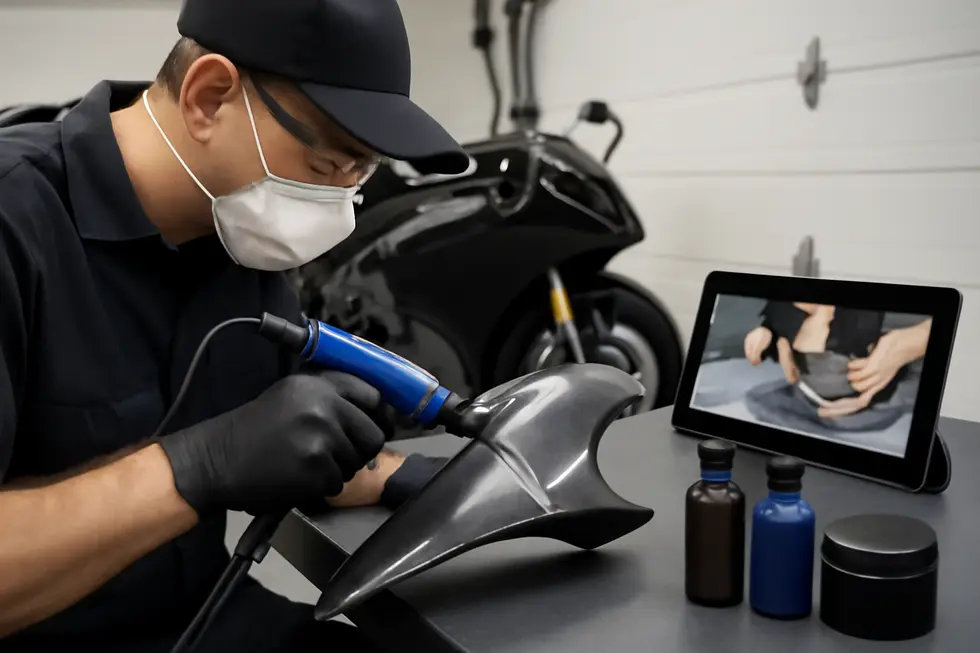
1. Cutting-Edge Materials and Precision Techniques Transforming Motorcycle Fairing Scratch Repairs
Technological progress in motorcycle fairing scratch repair hinges on the integration of innovative materials and precision manufacturing, which together elevate both repair quality and efficiency. Modern fairings increasingly utilize OEM-grade ABS plastic, engineered for superior impact resistance and durability. This enhanced material minimizes common damage, reducing the frequency and depth of scratches and cracks. Additionally, advancements in fiberglass and composite fairings involve improved resin formulations and UV-resistant coatings, which protect against fading, discoloration, and surface deterioration caused by prolonged sun exposure and environmental factors.
Precision manufacturing has revolutionized the maintenance landscape by employing sophisticated injection molding techniques and computer-aided design and manufacturing (CAD/CAM) systems. These technologies produce fairings that achieve exact OEM fitment, ensuring streamlined installation and reducing structural stresses that could cause further damage. The result is a far more durable, well-aligned part that inherently lessens the likelihood of future repairs.
Paint and coating processes have seen notable enhancements as well. Multi-stage professional finishes—often involving seven distinct layers—deliver high-gloss, scratch-resistant surfaces designed to withstand UV rays, abrasions, and chemical exposure. Embedded design elements via in-mold graphics not only maintain vibrant aesthetics longer but also add a protective layer beneath the surface. Specialized resin and UV-resistant coatings further guard the fairing’s color and surface integrity.
Some state-of-the-art fairings include integrated heat shields to combat discoloration and cracking from engine heat. This feature extends both the look and the structural integrity of the fairing, thereby reducing maintenance demands over time.
Collectively, these improvements cut down repair complexity and labor times, lowering costs while supporting the availability of superior aftermarket kits that rival OEM specifications. For a comprehensive understanding of the latest fairing options and customization insights, enthusiasts can explore resources like Summit Fairings’ detailed guides and selections.
2. Navigating Material Sensitivities and Environmental Obstacles in Motorcycle Fairing Scratch Repairs
Repairing scratches on motorcycle fairings requires a nuanced approach that respects the unique properties of materials like ABS plastic and fiberglass, alongside managing environmental impacts that can compromise repair outcomes. ABS plastic, valued for its resilience and lightweight nature, presents distinct challenges due to its susceptibility to heat. Excessive friction or high-speed buffing risks melting or warping its surface, making controlled, low-speed polishing essential to preserve integrity. When deeper scratches penetrate the paint, careful layering of touch-up paint and clear coat, paired with delicate sanding, is necessary to blend repairs seamlessly without damaging the plastic substrate.
Fiberglass fairings, conversely, demand gentler handling to avoid cracking or delamination. Overly aggressive buffing or abrasive techniques can cause structural compromise, so selecting softer buffing pads and applying minimal pressure helps maintain its strength and appearance. Beyond material sensitivities, environmental factors critically influence repair success. Surfaces often bear contaminants like oils, waxes, or silicones that impede paint adhesion and result in uneven finishes. Thorough cleaning using appropriate solvents specific to removing grease and residues is indispensable before sanding or painting to ensure the new layers adhere properly.
Moreover, humidity, temperature, and dust levels in the repair environment can affect drying times and surface smoothness, calling for controlled workspace conditions. Balancing these material-specific concerns with environmental management leads to effective scratch repairs that restore both the look and durability of motorcycle fairings. Understanding and adapting to these challenges allows repairs that extend fairing lifespan while preserving style, as elaborated in the comprehensive guides available through the resource center at Summit Fairings.
3. Essential Step-by-Step Techniques for Effective Motorcycle Fairing Scratch Restoration
Achieving a professional-quality repair on motorcycle fairings demands a considered and precise approach that balances care with effective restoration methods. The process begins with a detailed assessment of the scratch damage. Identifying whether scratches are superficial or deep determines the repair strategy—surface marks often respond well to polishing, while deeper gouges may need sanding, filling, and repainting. Cracks or breaks necessitate structural repairs like plastic welding to restore integrity beyond appearance.
Once the damage is evaluated, thorough cleaning is vital. Using mild soap and soft cloths removes dirt, grease, and oils that could otherwise compromise sanding or paint adhesion. Stubborn residues such as tar or glue require gentle, targeted removal techniques to avoid spreading contaminants, ensuring a clean and receptive surface for subsequent steps.
Sanding is approached with caution, beginning with coarser grit for deep scratches to level the damaged area, then progressing to finer grits to gently smooth the surface. Maintaining a wet environment during sanding prevents overheating of the plastic and reduces dust, preserving the fairing’s structural composition. After sanding, all debris must be meticulously cleaned away to prepare for polishing or painting.
Polishing with plastic-specific compounds restores clarity and gloss, applied carefully by hand to avoid heat buildup that could warp or melt the fairing material. This step refines the surface texture and enhances aesthetic appeal without risking new damage.
If scratches expose bare plastic, applying touch-up paint matched to the original color is essential. Masking protects surrounding areas, and multiple thin coats with proper drying times yield the best finish without runs or unevenness. This layered approach helps the repair blend seamlessly with the rest of the fairing, maintaining durability and visual continuity.
Following this step-by-step guidance ensures that scratch repairs not only improve appearance but also sustain the fairing’s protective functions, yielding long-lasting and satisfying restoration results. For further detailed insights on restoration approaches, consult comprehensive resources such as explore the best motorcycle fairings at Summit Fairings.
4. Navigating Cost, Quality, and Availability in Motorcycle Fairing Scratch Restoration
When addressing motorcycle fairing scratch repairs, riders and technicians must carefully balance cost, quality, and accessibility to achieve effective restoration without compromising performance or budget. The economic considerations begin with the choice between replacing fairings or investing in repair. Original Equipment Manufacturer (OEM) parts guarantee precise fitment and finish but carry a premium price. In contrast, many aftermarket suppliers offer durable ABS plastic fairings that match OEM specifications at a fraction of the cost, making them a practical alternative for budget-conscious riders seeking quality without overspending.
Labor expenses also significantly influence repair affordability. Skilled mechanics charge hourly rates that reflect their expertise, typically averaging around $125 per hour. This investment ensures the repair process preserves the fairing’s structural integrity while maintaining the aesthetic appeal. Opting for experienced professionals reduces the risk of damage from improper sanding, polishing, or repainting techniques, ultimately protecting the motorcycle’s value.
Accessibility further affects repair decisions. Aftermarket markets often provide an extensive range of fairings suitable for popular models, allowing quick sourcing and straightforward installation. However, locating parts for rare or vintage motorcycles remains challenging, as discontinued components fetch higher prices and limited availability can delay repairs. Comprehensive customer support and installation guides from suppliers add convenience, particularly for novice repairers aiming to reduce dependency on professional labor.
Integrating these factors, the ideal repair solution balances affordability with durability and ease of access. Selecting high-quality aftermarket fairings combined with expert labor maximizes value, while riders preserving vintage bikes need to factor in increased cost and sourcing complexity. Sustainable repair strategies also reduce environmental impact compared to full replacements. For riders seeking guidance on finding suitable parts and cost-effective repair options, exploring reliable aftermarket sources offers a solid starting point to restore their motorcycle’s fairings successfully.
For more insights into affordable and quality motorcycle fairing options, see this detailed overview of available solutions.
5. Fostering Rider Empowerment through Education: Enhancing Motorcycle Fairing Scratch Repair Skills and Community Impact
Empowering motorcycle owners with knowledge and skills in fairing scratch repair profoundly influences safety, sustainability, and economy. Educated riders can confidently undertake routine maintenance such as precise cleaning, careful wet sanding, and hand polishing, which helps prevent minor damages from escalating. This autonomy reduces reliance on expensive professional services while fostering mechanical literacy, a valuable asset for every motorcycle enthusiast.
Proper repair education also promotes vehicle longevity by ensuring that fairings continue to protect vital components and maintain aerodynamic performance. When riders understand how to handle scratches effectively, they avoid improper fixes that can exacerbate damage, potentially compromising safety or leading to costly replacements. Encouraging repair over replacement further benefits the environment by curbing plastic waste and lowering the carbon footprint associated with manufacturing new parts.
Beyond individual advantages, knowledge sharing creates supportive communities where riders exchange tips, tutorials, and experiences. This culture of informed repair stimulates local economies through demand for specialized products and repair services. Additionally, introducing mechanical skills early—often through approachable platforms like mini bikes—motivates novices and younger riders to develop maintenance competence, ensuring long-term engagement with proper care practices.
Comprehensive educational resources covering gentle sanding, polishing techniques, plastic welding, and refinishing bolster rider confidence. Such initiatives not only preserve the originality and value of motorcycles but also cultivate a responsible rider culture aligned with environmental care and economic empowerment. For riders seeking detailed practical guidance on repair methods, extended resources and tutorials are available at a trusted source dedicated to motorcycle fairings.
Final thoughts
Motorcycle fairing scratch repair presents both an opportunity and a challenge to business owners aiming to deliver superior service and maximize value for customers. By prioritizing meticulous preparation and polishing techniques, mastering the selection and application of appropriate materials, and understanding the economic benefits of repair over replacement, businesses can enhance profitability and customer satisfaction. Keeping abreast of advancements such as advanced composites, plastic welding, and protective coatings allows shops to stay competitive and handle diverse repair scenarios effectively. Addressing common challenges like avoiding surface damage and color mismatch further safeguards quality outcomes. Integrating practical maintenance advice not only extends the lifespan of repairs but also builds trust and repeat business. With these insights, repair-focused businesses can confidently elevate their expertise and reputation within the motorcycle industry.
Ready to elevate your ride? Summit Fairings delivers premium, custom-fit fairings that blend style and durability. Whether you’re chasing speed or turning heads, we’ve got your bike covered. Don’t wait—transform your machine today. Click, customize, and ride with confidence. Your perfect fairing is just a few clicks away. Act now!
About us
undefined
RELATED POSTS
View all

